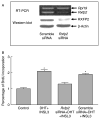The role of RXFP2 in mediating androgen-induced inguinoscrotal testis descent in LH receptor knockout mice
- PMID: 20154177
- PMCID: PMC3069714
- DOI: 10.1530/REP-09-0518
The role of RXFP2 in mediating androgen-induced inguinoscrotal testis descent in LH receptor knockout mice
Abstract
LH receptor knockout (LhrKO) male mice exhibit a bilateral cryptorchidism resulting from a developmental defect in the gubernaculum during the inguinoscrotal phase of testis descent, which is corrected by testosterone replacement therapy (TRT). In vivo and in vitro experiments were conducted to investigate the roles of the androgen receptor (AR) and RXFP2 signals in regulation of gubernacular development in LhrKO animals. This study demonstrated that AR and RXFP2 proteins were expressed in the gubernaculum during the entire postnatal period. TRT normalized gubernacular RXFP2 protein levels inLhrKO mice. Organ and primary cell cultures of gubernacula showed that 5alpha-dihydrotestosterone (DHT) upregulated the expression of Rxfp2 which was abolished by the addition of an AR antagonist, flutamide. A single s.c. testosterone injection also led to a significant increase in Rxfp2 mRNA levels in a time-dependent fashion in LhrKO animals. DHT, natural and synthetic insulin-like peptide 3 (INSL3), or relaxin alone did not affect proliferation of gubernacular mesenchymal cells, while co-treatments of DHT with either INSL3 or relaxin resulted in an increase in cell proliferation, and they also enhanced the mesenchymal cell differentiation toward the myogenic pathway, which included a decrease in a mesenchymal cell marker, CD44 and the expression of troponin. These effects were attenuated by the addition of flutamide, siRNA-mediated Rxfp2 knockdown, or by an INSL3 antagonist. Co-administration of an INSL3 antagonist curtailed TRT-induced inguinoscrotal testis descent in LhrKO mice. Our findings indicate that the RXFP2 signaling pathway plays an important role in mediating androgen action to stimulate gubernaculum development during inguinoscrotal testis descent.
Conflict of interest statement
The authors declare that there are no conflicts of interests that could be perceived as prejudicing the impartiality of the research reported.
Figures











References
-
- Amann RP, Veeramachaneni DN. Cryptorchidism in common eutherian mammals. Reproduction. 2007;133:541–561. - PubMed
-
- Anand-Ivell R, Heng K, Hafen B, Setchell B, Ivell R. Dynamics of INSL3 peptide expression in the rodent testis. Biology of Reproduction. 2009;81:480–487. - PubMed
-
- Barthold JS, Mahler HR, Newton BW. Lack of feminization of the cremaster nucleus in cryptorchid androgen insensitive rats. Journal of Urology. 1994;152:2280–2286. - PubMed
-
- Bathgate RA, Ivell R, Sanborn BM, Sherwood OD, Summers RJ. International Union of Pharmacology LVII: recommendations for the nomenclature of receptors for relaxin family peptides. Pharmacological Reviews. 2006;58:7–31. - PubMed
-
- Bogatcheva NV, Agoulnik AI. INSL3/LGR8 role in testicular descent and cryptorchidism. Reproductive Biomedicine Online. 2005;10:49–54. - PubMed
Publication types
MeSH terms
Substances
Grants and funding
LinkOut - more resources
Full Text Sources
Molecular Biology Databases
Research Materials
Miscellaneous

